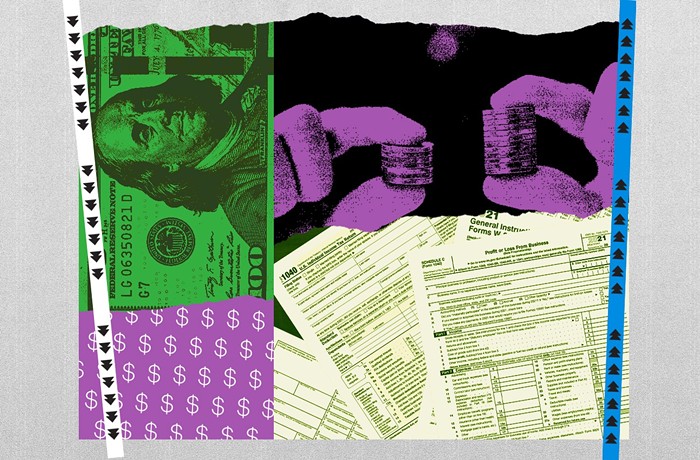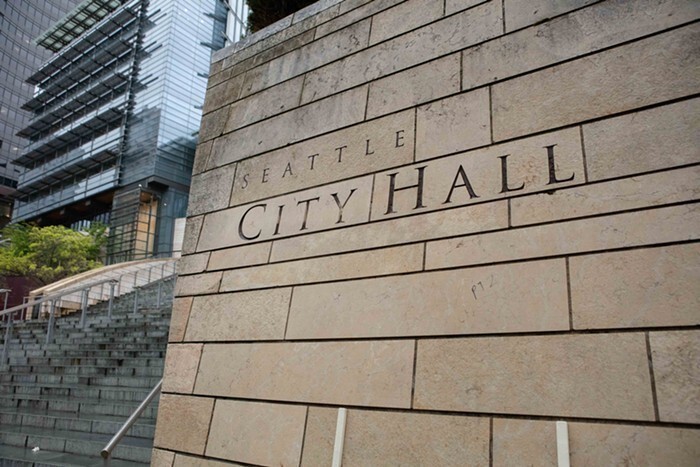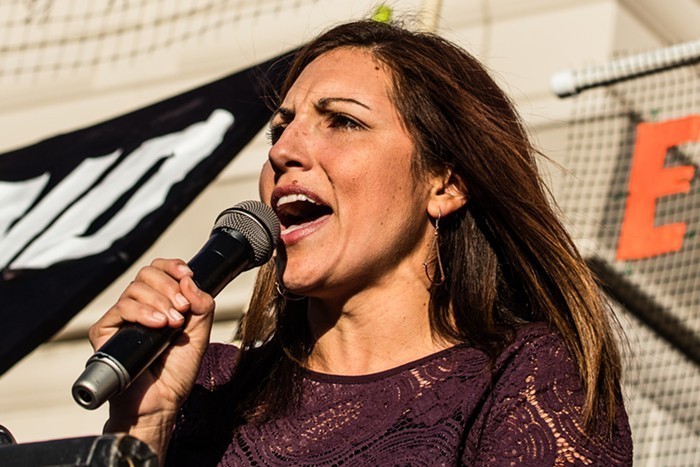Geologically speaking, Seattle sits on a hotbed of tectonic activity. We have our fractured plates; nerve lines of faults run under us. Just off the coast one tectonic plate is slowly subducted beneath another and seems to disappear; instead, it just changes the arrangement of its substance, gets pushed up into the distant ghost of a mountain, a volcano, a string of volcanoes you can see on a very clear day. Seattle looks tidy, but we're always being folded, scrunched, and reshaped.
And we have equal amounts of dramatic motion on our surface. Seattle is a city of double lives and secrets, where repression and darkness are counterbalanced by brilliant inventions, by explosions of politics and emotions. We sustain ourselves on outward displays of Victorian politeness, but we binge on irony and sarcasm. The Christian fundamentalism of our bedrock gets shaken, but never destroyed, by skeptical shocks.
My own first impressions of Seattle were, like Seattle, marked by an undertow of shadows, sins and secrets all masked by a stoic face. My family took a road trip from California to Seattle when I was six years old. The vacation was only remarkable because my sister Kat, who was 13 then, insisted we stop at church after small-town Catholic church along the snake spine of Highway 101. Kat wanted to confess a murder.
My brother, who is older than I am, remembers Kat taping to her mirror a newspaper clipping about an elderly woman, strangled in her sleep. My parents sent Kat to confession, but our parish priest wouldn't absolve her (he thought she was being melodramatic), so we left on vacation with Kat in a tortured state. In retrospect, I think Kat was attempting to express a burning and precise anger with no vent, no target in the context of our emotionally stunted family. What made it worse was that we ignored her, singing rounds of "You Are My Sunshine" over the gravelly roads of Kat's hysteria. I think it was during that vacation that I first perfected the art of the blank smile, the positive affect to guard against Kat's emotional quagmire. When we finally reached Seattle, Kat's murder story went quietly and neatly underground. Seattle is a city of subducted secrets. Her secret was safe here. I think it's still stuck somewhere in the sidewalk near Aurora and 85th.
Seattle unsettled my life 20 years later in a dark theater at a converted church in Santa Barbara. I was there with my husband, J. C., who was getting his Ph.D. in plate tectonics. His specialty was underwater volcanoes. We watched a documentary film called Streetwise, about street kids in Seattle. Watching Streetwise, I had a premonition that I was going to live in Seattle and work with those kids. J. C. and I went back home and ate cold cereal. He read Tintin comics, in his native French, at the table; I stared out the window.
Two years passed. The University of Washington recruited J. C. to be an associate professor of geophysics. We arrived in Seattle in October 1987, on Black Tuesday, the day the stock market tanked. We were as oblivious to that cataclysm as we were to our own emotional complexity. We stayed at the Geisha Inn on Aurora, which had round beds, red carpets, and a glass-enclosed, 24-hour hot tub. Cars pulled in and out of the parking lot all night. It took us days to conclude that it was a working motel for prostitutes.
All we focused on was being close to Green Lake and getting memberships at REI. We were religious about outdoor sports. We skied, we hiked, we camped; we had matching mountain bikes; we drove an Isuzu Trooper. We moved into a characterless apartment building full of other yuppie couples, all saving up for first houses. I was bored, pent up. I coped by binging on chocolate and working out. I also joined a charismatic Catholic prayer group that met on Capitol Hill.
I tried to be a nice, yuppie housewife. Plate tectonics ruined me.
J. C. left Seattle to go on a research excursion, mapping the separating sea floor off the coast of Ecuador. Remembering Streetwise, I went to volunteer at the Orion Center. Some kids from the film were still around. I was amazed by how emotionally direct the kids were. It was like being in a room with all of my raw, hidden feelings embodied and swearing in my face. Street kids seemed like hot spots, openings for liquid flames to slip through the strongest defense.
One day I was playing pool with a young Filipina girl who was dressed like a boy. She was tough; she scared me. It was my turn to shoot. As I bent down over the table, she leaned up on her pool cue and said, "You know, honey, you're a dyke."
I missed my shot. "I'm married," I answered.
"Whatever you say, Mrs. Dyke," she smiled. She sunk two stripes.
And she set in motion the subterranean mechanics that cracked my perfect yuppie façade. Everything that I was repressing--my homosexuality, my childhood darkness, even my sister's subducted anger--pushed up from the deep. I moved away until my former housewife self went underground. J. C. moved south. I came back to Seattle to work with street kids.
These days, I'm obsessed with Seattle's tectonic cycles: how we live beneath a canopy of clouds, inside our worn veneer of politeness, cycling through repression, expansion, the compulsion to destroy, then repression again. We have a distinct history and rhythm of expansion-contraction, of riots. Seattle was called the "Soviet of the West" in the 1930s, when radical labor leaned toward communism. In the '60s we had anti-war demonstrations. We're still too close to Seattle's WTO conference to see all the confused fractures and rifts it caused. Even on the eve of our Ash Wednesday earthquake, there were riots in Pioneer Square. Old anger recycled. Our unresolved class wars. What we ignore and repress returns to haunt us.
This essay is adapted from a talk Trisha Ready gave on February 27 (the day before the earthquake), as part of the Richard Hugo House's "Seattle and Its Meanings" lecture series.


















